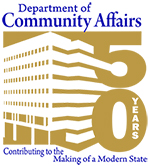![]()
Winter of 1980/81: Governor Byrne appoints Fire Safety Study Commission to review the state of first safety in New Jersey after fatal fires in Keansburg and Bradley Beach collectively claim the lives of more than 70 people.
February 1980: Governor Byrne signs Rooming and Boarding House Act into law. Department of Community Affairs begins to license owners and operators of rooming and boarding houses and enforces standards requiring that these facilities be constructed and operated so that the health, safety and welfare of residents are protected.
1981: Senior Citizen and Disabled Protected Tenancy Act signed into law to give senior citizens and disabled tenants the right to remain in their units as tenants for 40 years after a building is converted. Also, enforcement of the Handicapped Access Law is transferred from Treasury to the Department of Community Affairs.
November 22, 1981: Fire Safety Study Commission submits its report to Governor Byrne. The Commission presents two interim recommendations and nine major recommendations. The interim recommendations include authorizing the Department of Community Affairs to establish more stringent regulations requiring life safety improvements in boarding homes. The major recommendations include establishing within the Department of Community Affairs a permanent fire commission and office of fire safety, and adopting a statewide fire safety code.
January 12, 1982: Governor Byrne signs Boarding House Life Safety Act to establish more stringent regulations requiring life safety improvements in boarding homes in the wake of the fire tragedies in Keansburg and Bradley Beach.
1982: John P. Renna appointed sixth commissioner of the Department of Community Affairs.
1982: Administration of Community Services Block Grant moves to Department of Community Affairs. Also, DCA begins administering newly created Community Development Block Grant (CDBG) Small Cities Program.
1983: Local Authorities Fiscal Control Act (40A:5A-1 et seq.) is enacted to require Division of Local Government Services to review and approve all local authority and special district budgets.
1983: Mount Laurel II – New Jersey Supreme Court unanimously reaffirms Mount Laurel doctrine and encourages affordable housing legislation. Decision requires that municipalities in New Jersey use their zoning powers in an affirmative manner to provide a realistic opportunity for the production of housing affordable to low and moderate income households, as well as provide a fair share of its region’s affordable housing needs.
November 12, 1983: Governor Kean signs laws establishing a Statewide Uniform Fire Safety Act and creating the Bureau of Fire Safety within the Department of Community Affairs and the New Jersey Fire Safety Commission to advise the Commissioner of the Department of Community Affairs.
1984: By an act of the New Jersey State Legislature, the New Jersey Housing Finance Agency and the New Jersey Mortgage Finance Agency are merged to form the New Jersey Housing and Mortgage Finance Agency (HMFA). HMFA is established as an autonomous agency that is located administratively in the Department of Community Affairs. In practice, HMFA works closely with the Department of Community Affairs, combining its financing with the Department’s housing subsidy programs.
1984: Eight young adults die in fire at Great Adventure amusement park. Their deaths result in state regulations that require all “dark rides” to be equipped with fire sprinklers, emergency lighting, exit signs and an audible warning system.
1985: Neighborhood Preservation Balanced Housing Program established. The program creates housing in viable neighborhoods for households of low and moderate income and is funded by the New Jersey Realty Transfer Tax.
1985: Asbestos Hazard Abatement Subcode for educational facilities adopted.
July 2, 1985: Fair Housing Act becomes law. Act creates the Council on Affordable Housing (COAH), a state agency which allows municipalities to voluntarily devise a plan to comply with Mount Laurel and, by doing so, receive protection from builder’s remedy lawsuits.
1986: Leonard S. Coleman appointed seventh commissioner of the Department of Community Affairs.
1986: Housing and Mortgage Finance Agency becomes the official administrator in New Jersey of the federal Low Income Housing Tax Credits (LIHTC), providing the private market an incentive to invest in the creation of affordable rental housing.
1986: COAH adopts first round rules and fair share housing obligations for 1987-1993. From 1987 to 1993, COAH reviews and certifies 151 first round municipal housing elements and fair share plans.
1986: Continuing Care Retirement Community Regulation and Financial Disclosure Act signed into law.
1986: Barrier Free Subcode of the Uniform Construction Code is adopted.
1987: Department of Community Affairs moves to its present location at South Broad and Front streets. The building is named for William Ashby, a 98-year-old East Orange resident who founded the first National Urban League affiliate in New Jersey.
1988: Anthony M. Villane appointed eighth commissioner of the Department of Community Affairs.
1988: Five firefighters die at Hackensack Ford fire. Their deaths result in a state regulation that all buildings containing truss construction are labeled with a common statewide emblem to warn firefighters of their existence.
June 1988: Office of Hispanic Affairs initiates Hispanic Interns in Community Service Program.
1989: To promote homeownership, particularly for first-time buyers and urban households, the Housing and Mortgage Finance Agency sponsors a $256 million bond sale to finance between 2,500 and 3,000 below-market mortgages offered under a number of programs, including the Home Ownership for Performing Employees (HOPE) program, an employer-assisted mortgage product.
1989: Regulations for emergency shelters for the homeless are adopted. They mandate safety requirements for emergency shelters in New Jersey. Upon compliance with the regulations, the Department issues licenses to owners of these shelters for the purpose of ensuring that emergency shelters in the New Jersey are constructed, maintained and operated in such a manner as to protect the health, safety and welfare of their occupants.
